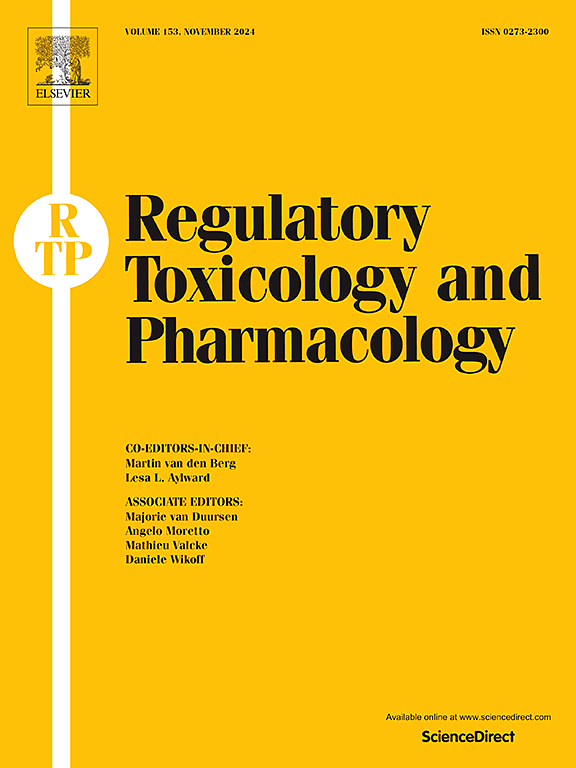Estimates of skin and blood concentrations of UV-filters: Insights from in vitro skin experiments
IF 3.5
4区 医学
Q1 MEDICINE, LEGAL
引用次数: 0
Abstract
Organic ultraviolet (UV) filters mitigate radiation transmission through the skin; however, uncertainties persist regarding their ability to cross the skin barrier and induce toxicity. Our aim was to use published in vitro skin permeation studies to predict UV-filter concentrations in blood and skin. In our review, we identified 35 papers reporting in vitro skin permeation of the 12 most used organic UV-filters. We estimated the UV-filters’ theoretical concentrations in blood and skin layers for two case scenarios and compared them with in vivo data. Five of the UV-filters penetrated skin as the parent compound, among these the highest estimated blood concentration was for benzophenone 4 (419 mg/L). These were overestimated (up to 100 times) compared to the reported in vivo results. Ten of the UV-filters permeated skin, among these ethylhexyl salicylate had the highest estimated skin concentration (15.99 g/cm3). Results from literature were inconsistent, likely due to different experimental in vitro methods. Although skin can metabolize chemicals, none of the included studies quantified potential UV-filter metabolites. We recommend future in vitro skin permeation studies to standardize the methods according to existing guidelines (including quantification of the metabolites) and screen UV-filters for possible skin absorption followed by a risk evaluation.
紫外线过滤器的皮肤和血液浓度的估计:来自体外皮肤实验的见解。
有机紫外线(UV)过滤器减轻辐射通过皮肤的传播;然而,关于它们穿越皮肤屏障和引起毒性的能力,仍然存在不确定性。我们的目的是使用已发表的体外皮肤渗透研究来预测血液和皮肤中的紫外线过滤器浓度。在我们的综述中,我们确定了35篇报道12种最常用的有机紫外线过滤器的体外皮肤渗透的论文。我们估计了两种情况下紫外线过滤器在血液和皮肤层中的理论浓度,并将其与体内数据进行了比较。五种紫外线滤光剂作为母体化合物穿透皮肤,其中估计血液浓度最高的是二苯甲酮4(419毫克/升)。与报道的体内结果相比,这些被高估了(高达100倍)。10种紫外线滤光剂渗透皮肤,其中水杨酸乙己酯的估计皮肤浓度最高(15.99 g/cm3)。文献结果不一致,可能是由于不同的体外实验方法所致。虽然皮肤可以代谢化学物质,但没有一项纳入的研究量化了潜在的紫外线过滤器代谢物。我们建议未来进行体外皮肤渗透研究,以根据现有指南(包括代谢物的量化)标准化方法,并在进行风险评估后筛选紫外线过滤器以确定可能的皮肤吸收。
本文章由计算机程序翻译,如有差异,请以英文原文为准。
求助全文
约1分钟内获得全文
求助全文
来源期刊
CiteScore
6.70
自引率
8.80%
发文量
147
审稿时长
58 days
期刊介绍:
Regulatory Toxicology and Pharmacology publishes peer reviewed articles that involve the generation, evaluation, and interpretation of experimental animal and human data that are of direct importance and relevance for regulatory authorities with respect to toxicological and pharmacological regulations in society. All peer-reviewed articles that are published should be devoted to improve the protection of human health and environment. Reviews and discussions are welcomed that address legal and/or regulatory decisions with respect to risk assessment and management of toxicological and pharmacological compounds on a scientific basis. It addresses an international readership of scientists, risk assessors and managers, and other professionals active in the field of human and environmental health.
Types of peer-reviewed articles published:
-Original research articles of relevance for regulatory aspects covering aspects including, but not limited to:
1.Factors influencing human sensitivity
2.Exposure science related to risk assessment
3.Alternative toxicological test methods
4.Frameworks for evaluation and integration of data in regulatory evaluations
5.Harmonization across regulatory agencies
6.Read-across methods and evaluations
-Contemporary Reviews on policy related Research issues
-Letters to the Editor
-Guest Editorials (by Invitation)

 求助内容:
求助内容: 应助结果提醒方式:
应助结果提醒方式:


